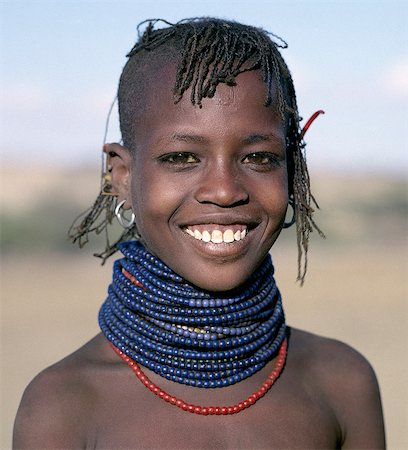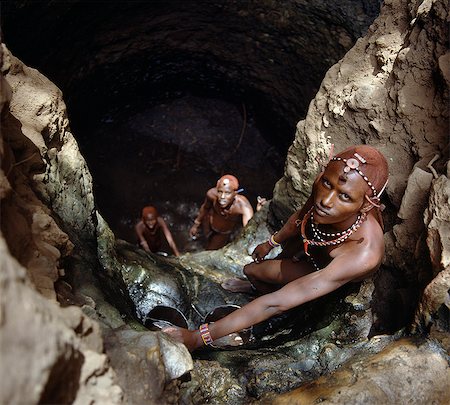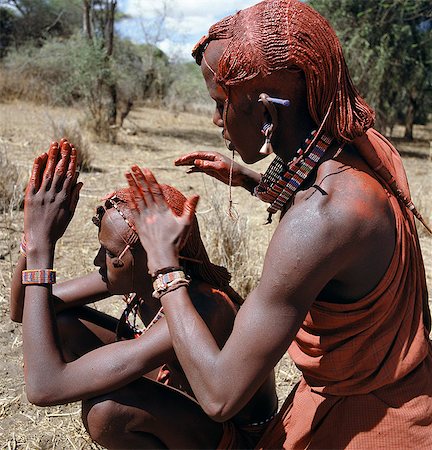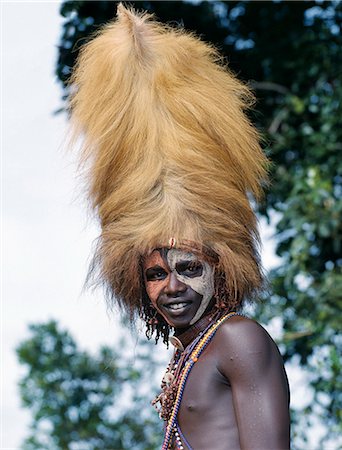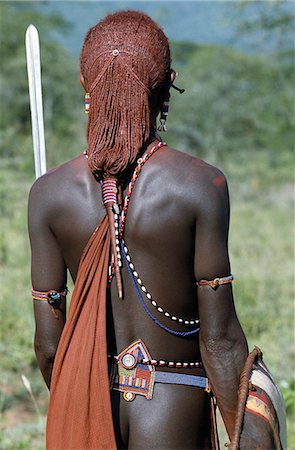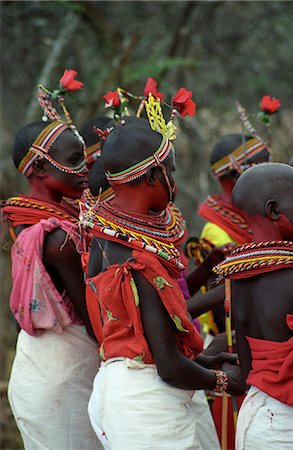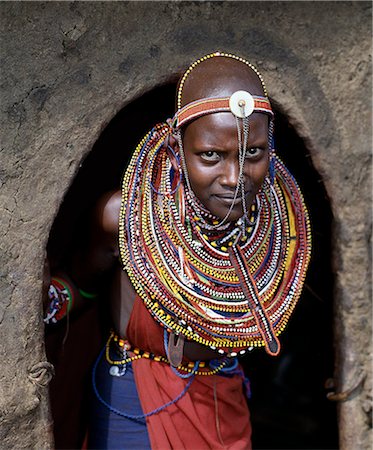-
A close-up of a Pokot woman's earrings,hairstyle and beaded ornaments. Only married women wear brass earrings and glass-beaded collars. The band over her head supports the weight of her heavy earrings.
Rights-Managed
-
A young married woman of the Pokot tribe. Her married status is denoted by her large brass earrings and broad beaded collars and necklaces that are smeared with animal fat to glisten in the sun.
Rights-Managed
-
A young Pokot girl in traditional attire. Girls wear leather skirts and capes made from home-tanned goatskins. Her broad necklaces are made from small segments of sedge grass. Her ears have already been pierced in four places,ready to insert the large brass earrings she will acquire after marriage.
Rights-Managed
-
A young Maasai girl wears a headband decorated with chains and cowrie shells that signifies her recent circumcision. Clitodectomy was commonly practiced by the Maasai but it is now gradually dying out.
Rights-Managed
-
Detail of a Maasai warrior's ear ornaments and other beaded or metal adornments. The Maasai practice of piercing ears in adolescence and gradually elongating the lobes is gradually dying out. This warrior's body and his long braids have been smeared with red ochre mixed with animal fat.
Rights-Managed
-
Two jovial Pokot girls set off with leather bags in search of edible berries. Pokot girls and women traditionally wore leather skirts and capes made from home-tanned goatskins. The necklaces of young girls are made from small segments of sedge grass.
Rights-Managed
-
A young Maasai girl keeps the holes in her pierced ears from closing with grass and rolled leaves. She will gradually stretch her earlobes by inserting progressively larger wooden plugs. By tradition,both Maasai men and women pierce and elongate their earlobes for decorative purposes.
Rights-Managed
-
A Datoga woman in traditional attire, which includes beautifully tanned and decorated leather dresses and coiled brass necklaces and ear ornaments.Extensive scarification of the face with raised circular patterns is not uncommon among women and girls.
Rights-Managed
-
A Datoga woman relaxes outside her thatched house.The traditional attire of Datoga women includes beautifully tanned and decorated leather dresses and coiled brass armulets and necklaces. Extensive scarification of the face with raised circular patterns is not uncommon among women and girls.
Rights-Managed
-
A Datoga woman relaxes outside her thatched house.The traditional attire of Datoga women includes beautifully tanned and decorated leather dresses and coiled brass armulets and necklaces.The Datoga live in northern Tanzania and are primarily pastoralists.
Rights-Managed
-
A young Maasai girl wearing a wooden plug in her pierced ear to elongate the earlobe. It has been a tradition of the Maasai for both men and women to pierce their ears and elongate their lobes for decorative purposes. Her two lower incisors have been removed - a common practice that may have resulted from an outbreak of lockjaw a long time ago.
Rights-Managed
-
A young Turkana girl has had the rims of her ears pierced in seven places and keeps the holes open with small wooden sticks. After marriage,she will hang leaf-shaped metal pendants from each hole.
Rights-Managed
-
An old Kikuyu lady picks coffee.Taken in the 1960's,this photograph depicts a traditional form of dress and ear ornaments among Kikuyu women,which has completely disappeared.
Rights-Managed
-
Up to a year before his circumcision,a Samburu boy will style his hair in a distinctive 'pudding bowl' shape and often rub charcoal and fat into it.Uncircumcised boys are considered children whatever their age. They have no standing in the tribe and do not belong to an age-set.
Rights-Managed
-
A pretty young Turkana girl has already had the flesh below her lower lip pierced in readiness for a brass ornament after her marriage. The rims of her ears have also been pierced and the holes kept open with small wooden sticks.
Rights-Managed
-
A young Turkana girl adorned with necklaces of a style the Southern Turkana prefer to wear.
Rights-Managed
-
A Turkana girl's necklaces are well-oiled with animal fat and glisten in the sun. Occasionally,a girl will put on so many necklaces that her vertebrae stretch and her neck muscles gradually weaken. The partially shaven head is typical of Turkana women and girls.
Rights-Managed
-
A Turkana girl's necklaces are well-oiled with animal fat and glisten in the sun. The use of red ochre has been copied from their Samburu neighbours and is not widespread. Occasionally,a girl will put on so many necklaces that her vertebrae stretch and her neck muscles gradually weaken. The partially shaven head is typical of Turkana women and girls.
Rights-Managed
-
A Turkana woman wears all the finery of her tribe: brass lip plug,beaded collar decorated with bleached shells of the African land snail,leaf-like ear ornaments and metal earrings from which hang tiny rings of goat horn.
Rights-Managed
-
A young Samburu man leads a donkey carrying the basic structure of a temporary home. The curved sticks will be tied together in a dome and covered with hides and woven mats to form a temporary shelter in a stock camp. Donkeys are widely used by the Samburu as beasts of burden.
Rights-Managed
-
Kenya, South Horr, Kurungu.A Samburu youth after his circumcision. The day after he has been circumcised, the initiate must hang in his pierced earlobes copper ear ornaments that are normally worn by married women. His sponsors make him a new headdress of ostrich feathers fastened to a narrow band of plaited fibre, which fits tightly round his forehead like a sweatband.
Rights-Managed
-
A Dassanech elder wearing a traditional clay hairdo, topped with ostrich feathers. His broad beaded necklace is unusual for its size but his five brass earrings are a common decoration of both men and women.The Dassanech people live in the Omo Delta of southwest Ethiopia, one of the largest inland deltas in the world.
Rights-Managed
-
An old Dassanech man wearing a traditional metal lip ornament and metal earrings. His broad ivory armbands and his ivory tobacco container hanging round his neck, are uncommon because elephants no longer frequent the Omo Delta.The Dassanech people live in the Omo Delta of southwest Ethiopia, one of the largest inland deltas in the world.
Rights-Managed
-
Maasai warriors draw water from a deep well. The depth of wells is measured by the number of men required to bring water to the cattle troughs at the top of them. A three-man well will be about 24 feet deep since the buckets are thrown between the men in a rhythmic chant.
Rights-Managed
-
A Maasai warrior resplendent with long ochred braids tied in a pigtail at the back,puts red ochre on his friend's plaits. Red ochre is anatural earth,which is mixed with animal fat to the consistency of greasepaint.
Rights-Managed
-
Kenya,Trans-Mara,Lolgorien. The Maasai do not eat game meat or birds. Consequently,the wildlife in their vast grazing areas has been left relatively undisturbed. The warriors do hunt lions,however,when their cattle are killed. The warrior who spears a lion to death will make a busby-style headdress from its mane.
Rights-Managed
-
A back view of a Maasai warrior resplendent with long ochred braids tied in a pigtail. This singular hairstyle sets him apart from other members of his society. His beaded belt is of a style only worn by warriors. The little copper bell-shaped ear ornament hanging from his elongated and decorated earlobe is also peculiar to the Maasai.
Rights-Managed
-
A Maasai warrior with his long braids and body coated with red ochre mixed with animal fat. He has put ochre dust round his eyes to enhance his appearance ready for a dance. The singular hairstyles of Maasai warriors sets them apart from other members of their society.
Rights-Managed
-
A Maasai warrior has daubed himself with red ochre mixed with animal fat to participate in a dance. His long ochred braids have been drawn forward from the crown of the head and tied in three places. This singular hairstyle sets warriors apart from the rest of their society.
Rights-Managed
-
A Maasai warrior resplendent with long ochred braids. His body has been smeared with red ochre mixed with animal fat while parts of his face have been covered with ochre powder.
Rights-Managed
-
Kenya,Kajiado,Maparasha. A Maasai warrior resplendent with long,ochred braids. This singular form of hairstyle distinguishes warriors from the rest of their society. This man has looped his elongated and decorated earlobes over his ears - a common practice when walking through thorn scrub country to prevent the loops being snagged by thorns.
Rights-Managed
-
A Maasai warrior in full regalia. He has stuck a porcupine quill in his beaded headband to add to his other decorations. His long,Ochred plaits have been drawn forward from the crown of his head and tied in three bunches.
Rights-Managed
-
Turkana women and girls are responsible for watering livestock,which is unusual among pastoral societies. Here,a young girl waters goats from a waterhole dug in the sand of a seasonal watercourse. Her young brother will control the flow of stock to the water trough. In the background,a man digs out another waterhole; they have to been deepened regularly towards the end of the dry season.
Rights-Managed
-
Turkana women and girls are responsible for watering livestock,which is unusual among pastoral societies. Here,a girl waters cattle from a Waterhole dug in the sand of a seasonal watercourse. The Turkana manipulate the horns of their ox's into perfect symmetry or any whimsical shape that takes the owner's fancy.
Rights-Managed
-
Maasai girls gather to celebrate a wedding. Their broad beaded necklaces with predominantly white glass beads mark then as Kisongo Maasai,the largest clan group of the tribe which lives either side of the Kenya-Tanzania border.
Rights-Managed
-
A warrior of the Kisongo section of the Maasai with his long Ochred braids decorated with beaded ornaments. His broad armulet is typical of the Kisongo living in northern Tanzania where white is the preferred colour of their beadwork.
Rights-Managed
-
Maasai warriors take enormous trouble over their appearance especially their long hair,which is braided,Ochred and decorated with beaded ornaments. This singular hairstyle sets them apart from the rest of their community.
Rights-Managed
-
Turkana girls return home from a Waterhole with water containers made of wood. Their cloaks are goatskin embellished with glass beads.
Rights-Managed
-
A Mursi woman wearing a large clay lip plate. Shortly before marriage, a girls lower lip will be pierced and progressively stretched over a year or so. The size of the lip plate often determines the quantum of the bride price. They live in a remote area of southwest Ethiopia along the Omo River, the country's largest river.
Rights-Managed
-
A Mursi woman wearing a large wooden lip plate. Shortly before marriage, a girls lower lip will be pierced and progressively stretched over a year or so. The size of the lip plate often determines the quantum of the bride price. They live in a remote area of southwest Ethiopia along the Omo River.
Rights-Managed
-
Shaded from the hot sun, a Karo woman grinds sorghum using large flat stones.It is customary for females of the tribe when in their teens to make a small hole in the flesh below their lower lips into which they put an ornament, this woman has used a small nail. Numerous heavy metal bracelets are worn by married womenThe Karo are a small tribe living in three main villages along the lower reaches o
Rights-Managed
-
A young Turkana girl wearing an attractively beaded leather apron and belt stands outside her mother's home. Sansevieria or wild sisal lines the lower walls of the house. Cicatrization round the nipples of a girl is not an uncommon form of beautification.
Rights-Managed
-
A Turkana girl in all her finery. Among the Turkana,cicatrization is a common form of beautification. She wears a crucifix given to her by a missionary; they are popular ornaments despite not necessarily being associated with Christianity.
Rights-Managed
-
Two Turkana girls set off to fetch water from a nearby Waterhole. Their water containers are made of wood by the women of the tribe. Their 'V' shaped aprons are made of goatskin and have been edged with hundreds and hundreds of round discs fashioned out of ostrich eggshells.
Rights-Managed
-
Black ostrich feathers decorate the front part of this Turkana man's traditional clay hairdo. Small metal chains,with or without beads attached to the ends of them,are commonplace ear ornaments.
Rights-Managed
-
A Samburu warrior has his Ochred hair braided by a friend. A mixture of cow's urine and ashes is often rubbed into the hair first to help straighten it. The wooden headrest is used as a pillow at night. Long braids of Ochred hair distinguish warriors from other members of their society. The warriors are vain and proud,taking great trouble over their appearance.
Rights-Managed
-
Two Samburu warriors dress the braids of a colleague. Long braids of Ochred hair distinguish warriors from other members of their society. The warriors are vain and proud,taking great trouble over their appearance. Round ornaments,often made of ivory,adorn the pierced and extended earlobes of warriors.
Rights-Managed
-
Two Samburu warriors converse,their long braids of Ochred hair distinguishing them from other members of their society. Samburu warriors are vain and proud,taking great trouble over their appearance. An ostrich feather pompom decorates the top of a spear.
Rights-Managed
-
A Samburu warrior resplendent with long braids of Ochred hair. His round ear ornaments are made of ivory. Samburu warriors are vain and proud,taking great trouble over their appearance. They use ochre extensively; it is a natural earth containing ferric oxide which is mixed with animal fat to the consistency of greasepaint. By tradition,warriors always used to carry two spears.
Rights-Managed
-
A Samburu warrior resplendent with his long braids of Ochred hair. His round ear ornaments are made of ivory. Samburu warriors are vain and proud,taking great trouble over their appearance. They use ochre extensively; it is a natural earth containing ferric oxide which is mixed with animal fat to the consistency of greasepaint.
Rights-Managed
-
A Samburu warrior resplendent with long,braided,Ochred hair. The braids at the front have been fashioned in a protruding fringe rather like a sunshade. The cloth on top keeps the braids in place. The round ear ornaments of the warriors are made of ivory. Samburu warriors are vain and proud,taking great trouble over their appearance.
Rights-Managed
-
A Samburu warrior resplendent with long,braided,Ochred hair. The round ear ornaments of the warriors are fashioned from ivory. Samburu warriors are vain and proud,taking great trouble over their appearance. Ochre is a natural earth containing ferric oxide which is mixed with animal fat to the consistency of greasepaint.
Rights-Managed
-
An old Datoga woman. Her traditional attire includes a beautifully tanned and decorated leather dress . The Datoga (known to their Maasai neighbours as the Mang'ati and to the Iraqw as Babaraig) live in northern Tanzania and are primarily pastoralists.
Rights-Managed
-
A Maasai woman wearing a very fine beaded necklace. The predominant white colour of her glass beadwork marks her as a Kisingo Maasai,the largest clan group of her tribe living either side of the Kenya-Tanzania border.
Rights-Managed
-
A Maasai girl in traditional attire. The predominant white colour of her beadwork and the circular scar on her cheek denote that she is from the Kisongo section of the Maasai,the largest clan group,which lives either side of the border in Kenya and Tanzania.
Rights-Managed
-
A Wa-Arusha warrior carries home a yoke. His brown necklace is made from aromatic wood. The Wa-Arusha are closely related to the Maasai and speak the same maa language. Unlike the Maasai,however,they till the land. In the past,this has brought them into conflict with their pastoral neighbors who disdained cultivation.
Rights-Managed
-
A Maasai warrior with his hair styled in a most unusual way. His long braids have been wrapped tightly in leather,decorated with beads and tied in an arch over his head. A colobus monkey tail sets this singular hairstyle apart from the more traditional warrior styles.
Rights-Managed
-
A Maasai woman in traditional attire. The preponderance of white glass beads in her ornaments denotes that she is from the Kisongo section of the Maasai,the largest clan group,which lives on both sides of the Kenya-Tanzania border.
Rights-Managed
-
A Maasai elder in traditional attire. Red has always been the preferred Maasai colour. Bell-shaped brass earrings are typically worn by the elders of the tribe.
Rights-Managed
-
A Dassanech girl braids her sister's hair at her village in the Omo Delta. Much the largest of the tribes in the Omo Valley numbering around 50,000,the Dassanech (also known as the Galeb,Changila or Merille) and Nilotic pastoralists and agriculturalists.
Rights-Managed
-
A Samburu woman singing. The strings of black and white beads hanging from her ears signify that she has two grown-up sons who are warriors of the tribe. Note: the traditional horn snuff container hanging from her neck.
Rights-Managed
-
The proud father of a Samburu boy who has recently been circumcised. For each son who has been initiated into the warrior age-set,a father will tie a strip of lion skin below his knees,hang two copper ornaments normally worn by women in his pierced earlobes and places a string of pale green beads round his forehead. A ceremonial leather cape is slung over his shoulder.
Rights-Managed
-
A Turkana woman sitting in the doorway of her hut. Her heavy mporro braided necklace identifies her as a married woman. Typical of her tribe,she wears many layers of bead necklaces and a beaded headband.
Rights-Managed
-
A Turkana woman sitting in the doorway of her hut. Her heavy mporro braided necklace identifies her as a married woman. Typical of her tribe,she wears many layers of bead necklaces and a beaded headband.
Rights-Managed
-
A Turkana woman,typically wearing many layers of bead necklaces and a series of hooped earrings with an pair of leaf-shaped earrrings at the front,sits in the entrance to her hut.
Rights-Managed
-
A Turkana woman,typically wearing many layers of bead necklaces and a series of hooped earrings with an pair of leaf-shaped earrrings at the front,sits in the entrance to her hut.
Rights-Managed
-
An old Turkana woman,typically wearing many layers of bead necklaces and a series of hooped earrings with an pair of leaf-shaped earrings at the front.
Rights-Managed
-
Young Maasai girls decorate their faces with ochre and clay in preparation for a dance.
Rights-Managed
-
A Maasai warrior blows a trumpet fashioned from the horn of a Greater Kudu. The strap is decorated with cowrie shells. Kudu-horn trumpets are only sounded to call men to arms or on ceremonial occasions.
Rights-Managed
-
A jovial group of Turkana girls in traditional attire. Their aprons are made of goatskin,either beaded or cut into thin strips before braiding. The two girls in the middle have already had the flesh below their lower lips pierced in readiness for a brass ornament after marriage.
Rights-Managed
-
Two young Karo girls stand in front of the massive trunk of a fig tree. A small Omotic tribe related to the Hamar,who live along the banks of the Omo River in southwestern Ethiopia,the Karo are renowned for their elaborate body painting using white chalk,crushed rock and other natural pigments.
Rights-Managed
-
Samburu girls are given strings of beads by their fathers when they are still young. As soon as they are old enough to have lovers from the warrior age set, they regularly receive gifts from them.Over a period of years, their necklaces can smother them up to their necks.
Rights-Managed
-
A Karo woman with her face painted in preparation for a dance in the village of Duss. A small Omotic tribe related to the Hamar, who live along the banks of the Omo River in southwestern Ethiopia, the Karo are renowned for their elaborate body painting using white chalk, crushed rock and other natural pigments. She is wearing a goatskin apron and carries a leather belt decorated with cowrie shells
Rights-Managed
-
A Karo women stands in the doorway to her hut in the village of Duss. A small Omotic tribe related to the Hamar, who live along the banks of the Omo River in southwestern Ethiopia, the Karo are renowned for their elaborate body painting using white chalk, crushed rock and other natural pigments. In addition to painting her face she has decorated her body with whorls of goat hair tied by leather co
Rights-Managed
-
A Samburu woman wearing a mporro necklace,which signifies her married status.These necklaces,once made of hair from giraffe tails,are now made from fibres of doum palm fronds (Hyphaene coriacea). The beads are mid-19th century Venetian glass beads,which were introduced to Samburuland by early hunters and traders.
Rights-Managed
-
A Samburu woman sews a leather cloak for her younger brother. For several weeks before a boy is circumcised,he must wear a charcoal-blackened cloak,which is made from three goatskins.
Rights-Managed
-
Gabbra women dance at a gathering in the village of Kalacha. The Gabbra are a Cushitic tribe of nomadic pastoralists living with their herds of camels and goats around the fringe of the Chalbi Desert.
Rights-Managed
-
Gabbra women dance at a gathering in the village of Kalacha. The Gabbra are a Cushitic tribe of nomadic pastoralists living with their herds of camels and goats around the fringe of the Chalbi Desert.
Rights-Managed
-
Gabbra women sing and dance to celebrate a wedding. The traditional metal ornamentation on their heads is called malmal.
Rights-Managed
-
A young Maasai girl in all her finery pauses at the entrance to her mother's home. The wall and roof of the house are plastered with a mixture of cow dung and soil.
Rights-Managed
-
Maasai girls in all their finery and with bells tied round their legs wait at the entrance to a house before dancing with warriors.
Rights-Managed
-
A young Maasai girl wears face paint and numerous beaded ornaments in preparation for a dance with warriors.
Rights-Managed














